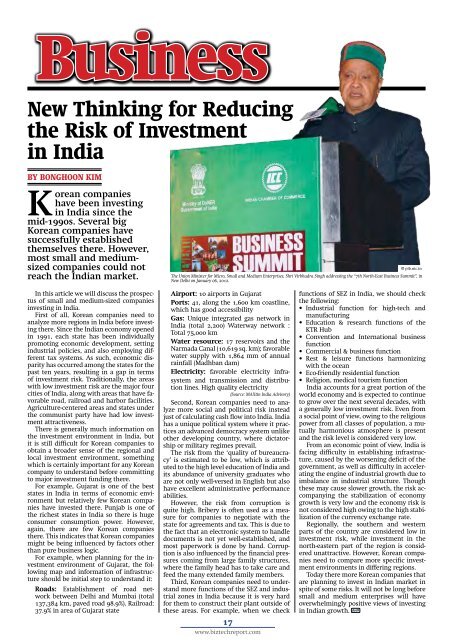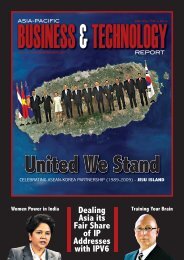INDIA-KOREA - Asia-Pacific Business and Technology Report
INDIA-KOREA - Asia-Pacific Business and Technology Report
INDIA-KOREA - Asia-Pacific Business and Technology Report
You also want an ePaper? Increase the reach of your titles
YUMPU automatically turns print PDFs into web optimized ePapers that Google loves.
<strong>Business</strong><br />
New Thinking for Reducing<br />
the Risk of Investment<br />
in India<br />
by Bonghoon Kim<br />
Korean companies<br />
have been investing<br />
in India since the<br />
mid-1990s. Several big<br />
Korean companies have<br />
successfully established<br />
themselves there. However,<br />
most small <strong>and</strong> mediumsized<br />
companies could not<br />
reach the Indian market.<br />
© pib.nic.in<br />
The Union Minister for Micro, Small <strong>and</strong> Medium Enterprises, Shri Virbhadra Singh addressing the “7th North-East <strong>Business</strong> Summit”, in<br />
New Delhi on January 06, 2012.<br />
In this article we will discuss the prospectus<br />
of small <strong>and</strong> medium-sized companies<br />
investing in India.<br />
First of all, Korean companies need to<br />
analyze more regions in India before investing<br />
there. Since the Indian economy opened<br />
in 1991, each state has been individually<br />
promoting economic development, setting<br />
industrial policies, <strong>and</strong> also employing different<br />
tax systems. As such, economic disparity<br />
has occurred among the states for the<br />
past ten years, resulting in a gap in terms<br />
of investment risk. Traditionally, the areas<br />
with low investment risk are the major four<br />
cities of India, along with areas that have favorable<br />
road, railroad <strong>and</strong> harbor facilities.<br />
Agriculture-centered areas <strong>and</strong> states under<br />
the communist party have had low investment<br />
attractiveness.<br />
There is generally much information on<br />
the investment environment in India, but<br />
it is still difficult for Korean companies to<br />
obtain a broader sense of the regional <strong>and</strong><br />
local investment environment, something<br />
which is certainly important for any Korean<br />
company to underst<strong>and</strong> before committing<br />
to major investment funding there.<br />
For example, Gujarat is one of the best<br />
states in India in terms of economic environment<br />
but relatively few Korean companies<br />
have invested there. Punjab is one of<br />
the richest states in India so there is huge<br />
consumer consumption power. However,<br />
again, there are few Korean companies<br />
there. This indicates that Korean companies<br />
might be being influenced by factors other<br />
than pure business logic.<br />
For example, when planning for the investment<br />
environment of Gujarat, the following<br />
map <strong>and</strong> information of infrastructure<br />
should be initial step to underst<strong>and</strong> it:<br />
Roads: Establishment of road network<br />
between Delhi <strong>and</strong> Mumbai (total<br />
137,384 km, paved road 98.9%). Railroad:<br />
37.9% in area of Gujarat state<br />
Airport: 10 airports in Gujarat<br />
Ports: 41, along the 1,600 km coastline,<br />
which has good accessibility<br />
Gas: Unique integrated gas network in<br />
India (total 2,200) Waterway network :<br />
Total 75,000 km<br />
Water resource: 17 reservoirs <strong>and</strong> the<br />
Narmada Canal (10,619 sq. km); favorable<br />
water supply with 1,864 mm of annual<br />
rainfall (Madhban dam)<br />
Electricity: favorable electricity infrasystem<br />
<strong>and</strong> transmission <strong>and</strong> distribution<br />
lines. High quality electricity<br />
(Source: MAXtin India Advisory)<br />
Second, Korean companies need to analyze<br />
more social <strong>and</strong> political risk instead<br />
just of calculating cash flow into India. India<br />
has a unique political system where it practices<br />
an advanced democracy system unlike<br />
other developing country, where dictatorship<br />
or military regimes prevail.<br />
The risk from the ‘quality of bureaucracy’<br />
is estimated to be low, which is attributed<br />
to the high level education of India <strong>and</strong><br />
its abundance of university graduates who<br />
are not only well-versed in English but also<br />
have excellent administrative performance<br />
abilities.<br />
However, the risk from corruption is<br />
quite high. Bribery is often used as a measure<br />
for companies to negotiate with the<br />
state for agreements <strong>and</strong> tax. This is due to<br />
the fact that an electronic system to h<strong>and</strong>le<br />
documents is not yet well-established, <strong>and</strong><br />
most paperwork is done by h<strong>and</strong>. Corruption<br />
is also influenced by the financial pressures<br />
coming from large family structures,<br />
where the family head has to take care <strong>and</strong><br />
feed the many extended family members.<br />
Third, Korean companies need to underst<strong>and</strong><br />
more functions of the SEZ <strong>and</strong> industrial<br />
zones in India because it is very hard<br />
for them to construct their plant outside of<br />
these areas. For example, when we check<br />
17<br />
www.biztechreport.com<br />
functions of SEZ in India, we should check<br />
the following:<br />
• industrial function for high-tech <strong>and</strong><br />
manufacturing<br />
• education & research functions of the<br />
KTR Hub<br />
• Convention <strong>and</strong> International business<br />
function<br />
• Commercial & business function<br />
• rest & leisure functions harmonizing<br />
with the ocean<br />
• eco-friendly residential function<br />
• religion, medical tourism function<br />
India accounts for a great portion of the<br />
world economy <strong>and</strong> is expected to continue<br />
to grow over the next several decades, with<br />
a generally low investment risk. Even from<br />
a social point of view, owing to the religious<br />
power from all classes of population, a mutually<br />
harmonious atmosphere is present<br />
<strong>and</strong> the risk level is considered very low.<br />
From an economic point of view, India is<br />
facing difficulty in establishing infrastructure,<br />
caused by the worsening deficit of the<br />
government, as well as difficulty in accelerating<br />
the engine of industrial growth due to<br />
imbalance in industrial structure. Though<br />
these may cause slower growth, the risk accompanying<br />
the stabilization of economy<br />
growth is very low <strong>and</strong> the economy risk is<br />
not considered high owing to the high stabilization<br />
of the currency exchange rate.<br />
Regionally, the southern <strong>and</strong> western<br />
parts of the country are considered low in<br />
investment risk, while investment in the<br />
north-eastern part of the region is considered<br />
unattractive. However, Korean companies<br />
need to compare more specific investment<br />
environments in differing regions.<br />
Today there more Korean companies that<br />
are planning to invest in Indian market in<br />
spite of some risks. It will not be long before<br />
small <strong>and</strong> medium enterprises will have<br />
overwhelmingly positive views of investing<br />
in Indian growth. A-P









